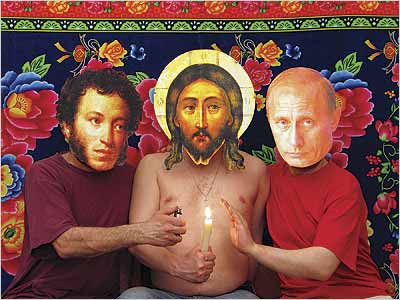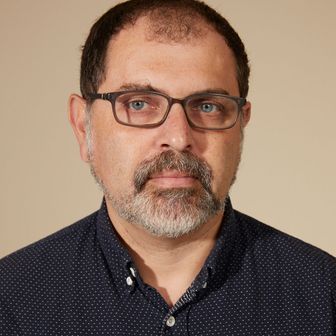
It’s been estimated that, if not for Stalin, a revolution, and two world wars, there’d be about 100 million more people alive in the former Soviet Union. As the Guggenheim’s bombastic Putin-sanctioned “Russia!” exhibit finishes up its run, it bears remembering the paintings not painted, the Chagalls who never made it to Paris, the Yiddish writers summarily shot, and the cautious Soviet talents who thought better of straying from the trite steelworkers and tractors mandated by socialist realism. Ever heard of Ikhil Shraibman? He was one of a handful of Yiddish fabulists who survived Stalin. He died last month in Moldova, age 93, obscure and underappreciated. He was one of the lucky ones.
Two new American novels serve as reminders of what was lost. At least one of them—Olga Grushin’s The Dream Life of Sukhanov—will tower over the majority of what publishers put out this year, though the less successfulThe World to Come, by Dara Horn, is still a worthy tribute to Russia’s ill-fated artists. At the start of Horn’s book, a study for Chagall’s Over Vitebsk, valued at $1 million, is stolen from a New York City Jewish institution during a singles mixer. The sketch, it turns out, has a long and complicated provenance. Given by the artist to a Jewish orphan named Boris Kulbak, it moves through the family after Kulbak is executed for “Zionist” activities in 1951. His betrayer, Sergei Popov, is a brutish apparatchik tasked with identifying artistic forgeries and performing other, less official work—like running over enemies of the people with a truck.
The protagonist of The Dream Life of Sukhanov—the first novel by Grushin, a Russian immigrant—is a mellowed and decayed successor to Popov. In 1985, Soviet officials no longer run over dissidents. They simply strike them from the record. Anatoly Sukhanov, an unbearably smug hypocrite, polices state-sanctioned art criticism. Thanks to his father-in-law, a celebrated but dreadful painter named Pyotr Malinin, he has ascended to editor-in-chief of Art of the World—think Pravda crossed with Artforum. Sukhanov pores over others’ essays, “crossing out every occurrence of ‘biblical’ and ‘eternal’ and putting a fat question mark next to every mention of ‘love.’ ” He is “famous,” Grushin writes, “for his skillful omissions.”
Sukhanov is less successful at omitting his own conflicted past, which reemerges with paralyzing flashbacks after a forgotten cousin—perhaps imaginary—arrives at his door. Dream sequences seem to leave remnants in waking life, so that before long, dream, memory, and “reality” are barely distinguishable, and artistic longing becomes a symptom—and cause—of madness.
In this book, too, Chagall, an expressionist deemed dangerous to the totalitarian state, is a primary influence. At school, Sukhanov—whose newly turbulent memory reveals that he was once tutored by a Chagall disciple—chafed privately at socialist realism. And following Stalin’s death, when culture flowered briefly (before the Prague Spring, there was a Soviet thaw), he himself painted expressionist works—before being denounced by Khrushchev and persuaded to betray his principles. In a pivotal argument with Sukhanov, his father-in-law, Malinin, echoes Dostoevsky’s Grand Inquisitor, except that he’s an agent of the state rather than the church: “[Realism] may not be as amusing as some fantasy by Chagall, but when millions of tired, unhappy men and women want to find a bit of light, hope, or encouragement at the end of their hard day, they would rather look at paintings of the heroic past and the harmonious future than puzzle over some portrait of a man with an upside-down green face.”
It’s exactly what the Inquisitor told Jesus: We don’t need you. Sukhanov, remembering a secret visit deep inside the state gallery, gets the message. He thinks “of Chagall’s masterpieces imprisoned in an anonymous storage room of the Tretyakovka mildewing away brushstroke by brushstroke … For painting, unlike literature, was a tragic art: it could not be multiplied in a predawn hour on a rickety typewriter, or cross borders sewn into a coat lining, or live forever, weightless and unstoppable, in a dark, safe corner of someone’s memory.”
When they’re not writing about art being rubbed out or exiled in deep storage, both Horn and Grushin vividly describe the joy of visual creation, but it’s no accident that Horn’s most expressive moments depict acts of plagiarism. Or, you could say, appropriation. In her book, writing does survive through copying and oral tradition, as Kulbak’s grandson gets the chance to save an executed Yiddish writer’s concealed manuscripts. That writer, Der Nister (“The Hidden One”), had himself grown resentful of Chagall’s success—a success that, paradoxically, was based on the very thing that made him anathema to the Soviets: the universality of his message-free art.
At key moments, Horn seems to side with Der Nister—art must mean something, if only the survival of an oppressed culture. A Yiddish scholar, she offers an appendix acknowledging the many sources for her more fantastical elements—the kinds of embedded fables you’ll find in work by Jonathan Safran Foer and Nicole Krauss. But Horn never rises to their imaginative heights. She both promotes and embodies the notion of artist as archivist.
Grushin, too, owes a debt to her forebears. She has claimed Nabokov—an exiled aesthete like Chagall—as her favorite writer, and it’s the sheer pleasure of his labyrinthine plots and luminous writing to which she aspires. But unlike Horn, she isn’t telling old stories in a new context. You can almost see Horn straining to find that “heroic past” and “harmonious future” that Malinin prattles on about—only in the service of the victims. By contrast, Grushin’s beautifully constructed puzzle is a triumph of singular yet universal genius, the upside-down green head reasserting itself.
At times literally. Having accommodated himself to the system all too well, Sukhanov is blindsided when his glasnost-inspired colleagues kill his article condemning Dalí and publish a celebration of—who else?—Chagall. Sukhanov’s ruin, like his country’s, is precipitated by the decline of communism. His own children, a social-climber and a sullen punk, are far better suited to the coming capitalist anarchy of post-Soviet Russia.
These days, though, that anarchy is giving way to resurgent authoritarianism. When a group of artists mounted a response to the “Russia!” exhibit—a collection of protest art called “Russia 2,” now visiting Chelsea’s White Box gallery—they were sued by state-allied artists on charges tantamount to blasphemy. Russia’s twin legacies—artistic genius and political repression—continue their uneasy coexistence. But with a difference: Books like Horn’s and Grushin’s are no longer samizdat in Russia, and this generation is not (yet) legally enjoined from absorbing the lessons of its own past.

Like many elements of Horn’s book, the Chagall theft is based on fact. A gouache study by the artist for Over Vitebsk, valued at $1 million, was stolen during a singles mixer at the Jewish Museum in June 2001 while on loan from a private St. Petersburg collector. A few days later, the museum received a ransom note from a group calling itself the International Committee for Art and Peace, demanding peace in the Middle East as a condition of its return. The trail went cold until, the following January, the painting was found as undeliverable mail in a Topeka, Kansas, post office. It now hangs in St. Petersburg’s Russian Museum.
The Dream Life of Sukhanov
Olga Grushin.
Putnam.
356 pages. $24.95.
The World to Come
Dara Horn.
Norton.
315 pages. $24.95.
